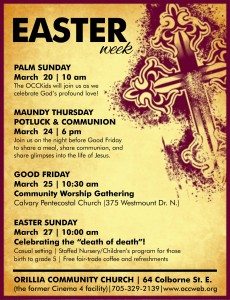The Gospel of Mark seems to end on an odd note: v8 “The women fled from the tomb, trembling and bewildered, and they said nothing to anyone because they were too frightened.” It’s even odder in the Greek, since it ends with the preposition γάρ which we translate as “for” or “because.”
There are several possible endings to the Gospel of Mark:
- Two of the oldest and most respected manuscripts, the Codex Sinaiticus (AD 375) and Codex Vaticanus (AD 350) end at v8.
- Others have the “longer ending” of vv9-10.
- Some have what is called the “shorter ending” after v8. “They reported briefly to those around Peter all that they had been commanded. After these things Jesus himself sent out through them, from the east to the west, the holy and imperishable preaching of eternal salvation. Amen.”
- There are a few later manuscripts which include both the “shorter” and the “longer” ending.
- And there have been some scholars who have suggested that the ending of Mark’s Gospel was lost, or torn off, and that is why it seems to end abruptly at the end of v8.
The main arguments for saying that Mark ends at v9 are as follows. Some dispute some of these arguments, but on the whole each of them is a strong argument, and taking several together gives an even stronger argument.
- The long ending does not appear in several of our earliest and best manuscripts, most notably Sinaiticus and Vaticanus.
- Some early manuscripts which do contain the long ending nonetheless contain indications marking it as disputed.
- The existence of manuscripts containing a different ending entirely (the “shorter ending”) also suggests that the original contained no ending beyond v8.
- The author of Mark has a distinctive Greek style, and the long ending does not match this style.
- The author of the long ending appears to be familiar with possibly Matthew and probably Luke.
- The early copies of Matthew and Luke do not have had the long ending in their copies of Mark.
The King James Version of the Bible, as well as the New King James Version, contains vv9-20 because the King James used medieval manuscripts (which were the oldest manuscripts they had at their disposal) as the basis of its translation. Since 1611, however, older and more accurate manuscripts have been discovered that do not include vv9-20.
In addition, the 4th century church fathers Eusebius and Jerome noted that almost all Greek manuscripts available to them lacked vv9-20, although they doubtless knew those other endings existed. In the 2nd century, Justin Martyr and Tatian knew about other endings. Irenaeus, in AD 150-200, must have known about this long ending because he quotes v19 from it. So, the early church fathers knew of the added verses, but even by the 4th century, Eusebius said the Greek manuscripts did not include these endings in the originals.
The internal evidence from this passage also casts doubt on Mark as the author. For one thing, the transition between verses 8 and 9 is abrupt and awkward. The Greek word translated “now” that begins v9 should link it to what follows, as the use of the word “now” does in the other synoptic Gospels. However, what follows doesn’t continue the story of the women referred to in v8, describing instead Jesus’ appearing to Mary Magdalene. There’s no transition there, but rather an abrupt change, lacking the continuity typical of Mark’s narrative. The author should be continuing the story of the women based on the word “now,” not jumping to the appearance to Mary Magdalene. Further, for Mark to introduce Mary Magdalene here as though for the very first time (v9) is odd because she had already been introduced in Mark’s narrative (Mark 15:40, 47, 16:1), suggesting that this section was not written by Mark.
The vocabulary is also not consistent with Mark’s Gospel. These last verses don’t read like Mark’s. There are several words here that are never used anywhere by Mark, and the structure is different from the familiar structure of his writing. The title “Lord Jesus,” used in v19, is never used anywhere else by Mark. Also, the reference to signs in vv17-18 doesn’t appear in any of the four Gospels. In no account, post-resurrection of Jesus, is there any discussion of signs like picking up serpents, speaking with tongues, drinking poison, or laying hands on the sick. So, both internally and externally, this seems to be foreign to Mark.
While the added ending does not contradict previously revealed events, both the external and internal evidence seem to indicate that Mark did not write it.
In reality, ending his Gospel in v8 with the description of the amazement of the women at the tomb is entirely consistent with the rest of the narrative. Amazement at the Lord Jesus seems to be a theme with Mark. “They were amazed at his teaching” (Mark 1:22); “They were all amazed, so that they debated among themselves” (Mark 1:27); “He healed the paralytic, and they were all amazed and were glorifying God saying, ‘We’ve never seen anything like this’” (Mark 2:12). Astonishment at the work of Jesus is revealed throughout Mark’s Gospel (Mark 4:41; 5:15, 22, 42; 6:51; 9:6, 15, 32; 10:24, 32; 11:18; 12:17; 16:5).
My purpose in writing this is not to try to undermine the authority of God’s Word. But to recognize that the ending of Mark’s Gospel is under dispute. To fail to spotlight this issue when dealing with the historic reliability and inspiration of the New Testament manuscripts is to be less than honest, and thus affect our credibility in sharing the good news (gospel) of Jesus.

